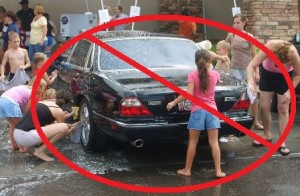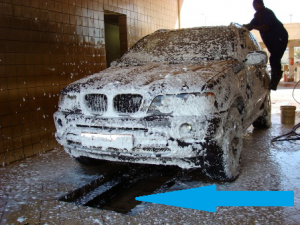That song always makes me smile—and think of that fish movie with one of the characters working at a car wash, Will Smith is the voice but I’m blanking out on the movie name. Anyway, on to topic! Car washing is one thing I get calls about a lot while in water restrictions. In the City’s Drought Ordinance, there is a section on vehicle washing–what day it’s permitted on, what kinds of vehicles are permitted to be washed, charity car washes…maybe you’re wondering, what’s the big deal with washing a car? Most people don’t let the water run the entire time the car is being washed, so it’s not completely a water use issue. It’s also a water quality issue.
It’s also a water quality issue.
The majority of the answer really lies with WHERE the car wash is taking place. Some places are definitely better then others in terms of protecting our water. A commercial car washing facility, whether that’s the drive-thru bays that you wash it yourself with the spray gun, or the full-service wash facilities are the best places to wash your car. Why? you ask.
Well, let’s start with washing a car at home. It’s typically just soaped up, washed, and rinsed off in the driveway. Where does all the water (and soap and dirt) go that’s rinsed off the vehicle? Down the driveway, down the street, down the gutter and into the storm drain. But…where does the water (or other things) go when it goes down that hole in the side of the street? If you’ve read my blog on leaves, then you know the answer! It goes out to our creeks and water ways, NOT to the waste water treatment facility. Not to any other place that cleans that water before it hits nature. So, all the suds, dirt, grease, oil, or cleaning chemicals are going to our creeks. This can be harmful to plants and animals that live in these areas, but it’s also a pollutant to our water.
A way to prevent this–if you’re a die-hard car washer at home–is to pull the car up onto the grass in your yard to wash it. I remember my mom doing this all this time growing up, and honestly don’t remember watering the grass much, if ever. By washing the car on the grass you are watering your yard! And the chemicals and soaps get filtered out of the water naturally by using the grass and soil; as the water and what’s in it, moves down through the soil, the dirty stuff get filtered out, while the water keeps moving down. It’s a win-win for you, the water quality, and your yard.
So what do commercial car wash facilities have that we don’t have at home? They have big tanks under the ground (which our yard is a substitute for) that collects the water that was used while your vehicle is being washed. That’s where the water goes when it goes down the holes in bay there (see the blue arrow at right). The dirty water is collected and filtered and then either released into the City’s waste water system, so that it can go to the waste water treatment plant to be cleaned up. Or in the cases of newer car washes, the water is captured, cleaned up, and reused again.
This is important–this is why commercial car washes are allowed to continue business during drought restrictions. They are reusing water, and they are helping protect the waterways by sending water to the waste water plant, rather than the storm sewer.
They don’t actually use as much water as the perception is either. An efficient automatic, drive-thru type of car wash facility uses around 30-50 gallons per vehicle. That’s less than some clothes washers use! Studies show that at home, we use around 100 gallons to wash one car.
So, please use the best judgment when it comes to keeping your car clean and protecting our water.


